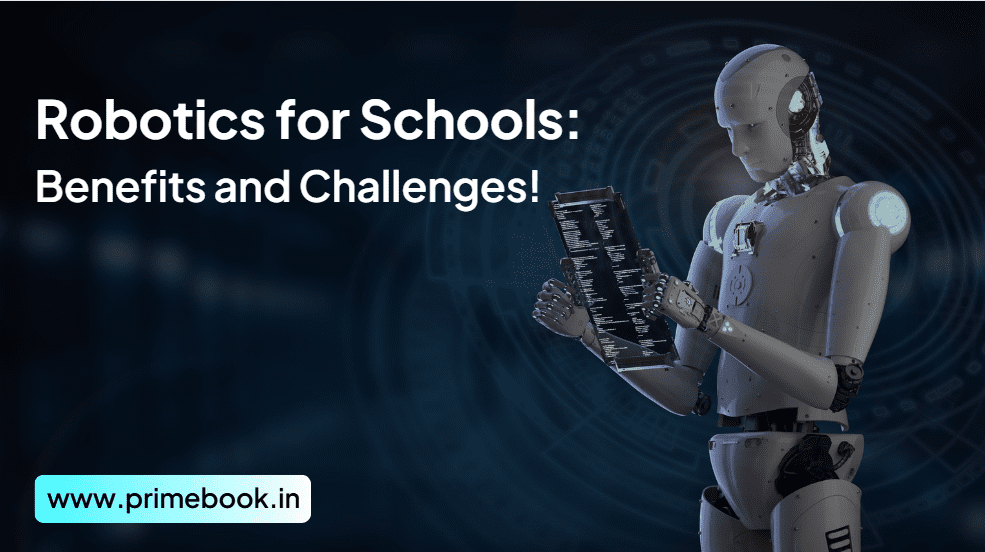Blogs / Trendy Tech Talks / Robotics for Schools: Benefits and Challenges!
Blogs / Trendy Tech Talks / Robotics for Schools: Benefits and Challenges!

Ananya Dasgupta
18 Jun 2024

Robotics for Schools: Benefits and Challenges!
Table of Contents
Educational robotics is all set to transform the learning landscape across the globe by equipping students with essential skills, vital in the year to come, while AI and robotics shall become integral to our daily lives. By combining the power of technology and engineering with human creativity, robotics appears with multiple benefits for schools. However, as a rising technology, it has certain challenges, too! This blog shall unfold all of the benefits and challenges of robotics for schools.
What Is Robotics?
The interdisciplinary study of the design, construction, operation, testing, and use of robots is what we call robotics! It’s a rapidly growing field and the main goal here is to create humanoid machines or parts that can help assist humans in various everyday activities.
The disciplines that collectively contribute to robotics are – Mechanical Engineering, Computer Science, Electronics & Telecommunication, Electrical Engineering, Material Engineering, and so forth.
The word “robot” holds root in the Czech word “robota” implying “forced labour”. These are programmable machines meant to complete a task with a level of autonomy. Robotics involve building different kinds of robots, such as – Humanoid Robots, Industrial Robots, Cobots, Agricultural Robots, Medical Robots, Augmenting Robots, and Software Bots.
Benefits of Robotics in Schools
Here is the list of benefits robotics offers to prepare school students for the future.
1. Promotes Practical, Interactive Learning
One of the biggest benefits of robotics in schools is that it empowers students with the hands-on ability to experiment with robots, build, program, and test them. Such a practical and interactive learning experience can help students understand abstract and complex concepts deeply. It makes lessons more engaging and relevant.
2. Boosts Critical Thinking & Creativity Skills
Another significant benefit of robotics in schools is the enhancement of students’ critical thinking, problem-solving, creativity, and imagination skills. This is because robotics demands students to analyze problems with precision, break them down into smaller parts, identify patterns, and think of effective, out-of-the-box solutions.
3. Enables Learning with Hit & Trial
The capability to learn through hit and trail is again a benefit of robotics for schools. This allows students to work with the different robotic elements and take risks without the fear of getting penalized for mistakes. Such a learning approach intrigues students’ motivation and empowers them to inculcate their utmost productivity.
4. Empowers Self-Assessment Abilities
The incorporation of robotics curriculum in schools also holds the benefit of letting students assess their own work and identify areas of strengths and weaknesses. This, in turn, can help students improve their theoretical knowledge and practical application of robotics and related technologies.
5. Prepares Students for Better Career Opportunities
Above all, robotics in schools benefits students with better career prospects as it is a part of STEM education, which stands vital in the 21st-century digital era. The job sectors in recent times are keener to hire talents from the STEM fields. Therefore, such knowledge dissemination from the early education levels can help students succeed in their desired career path.
Challenges of Educational Robotics
Despite the massive boons of educational robotics, certain challenges need to be addressed to unleash the complete potential of this robust technology.
1. Resource Expense
The first challenge of educational robotics is that the equipment and kits come at expensive prices, making it difficult for schools in the Tier 2 and 3 cities of India to afford them because of their limited budget. To address this challenge, partnership with community organizations and local businesses can be a significant approach. Schools need to explore various grants and sponsorships or start with the basic low-cost, open-source robotics platform.
2. Teacher’s Training
Another challenge herein is the lack of experience with educational robotics among teachers in India. To address this issue, teachers need proper robotics training and support. Workshops and personality development programs can be a great option to empower Indian facilities with the skills and confidence to incorporate robotics in the classroom. Collaboration among the teachers on the best practices is also vital in this context.
3. Diversity & Inclusion
While it is necessary to make educational robotics accessible to all students, the diverse demography of this country and the vivid socio-economic differences make it a little difficult. Incorporating culturally relevant content in educational robotics and offering diverse role models can help create an inclusive and welcoming environment for robotics in schools.
Also Read: Using Gamification in The Classroom
To sum up, affordable and effective integration of robotics into the curriculums and classrooms in India can lead future generations towards becoming efficient innovators and problem solvers. But, to make that happen, the accessibility of robotics in all schools and teachers’ readiness stands as the key!


 Related Blog
Related Blog









